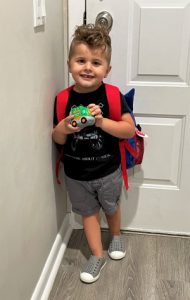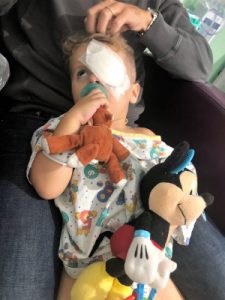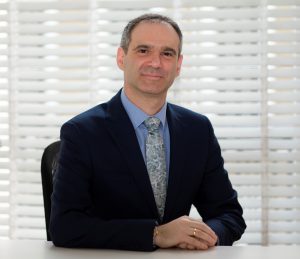Boy’s vision improves after undergoing Compassionate Use gene therapy in UK for LCA4 (AIPL1)
DJ and Brendan Broadbin came to our Hope in Focus LCA Family Conference with a lot of questions about their little boy’s blindness, and they left with amazing answers leading to innovative treatment for his type of Leber congenital amaurosis (LCA).
The couple traveled from their southwestern Connecticut home to the July 2019 Philadelphia conference knowing their son Jace had LCA, but not knowing the specific form of the rare disease because their 11-month-old had yet to be tested genetically.

Jace ready for the day
Jace’s parents introduced themselves to retinal specialist Prof. Michel Michaelides, one of Britain’s top ophthalmologists, a founding member of MeiraGTx, where he is Head of Clinical Ophthalmology, and a conference panelist.
“At that time,” DJ said, “we hadn’t even met with a geneticist yet, but Michel gave us his contact information ‘just to have.’ We then got to hear the panel discussion at the conference regarding the clinical trials that were taking place across several of the gene variants.
“A few days before we went to Boston to hear Jace’s genetic results (in October 2019, three months after the conference), we received the Sofia Sees Hope (now Hope in Focus) newsletter in the mail, outlining the treatments that were discussed at the conference.
“We brought the newsletter with us to our appointment and almost fell out of our seats when we learned that Jace had the AIPL1 variant, and that MeiraGTx was currently working on treatment through the Compassionate Use case program in the UK – we emailed Michel that same day.”
Compassionate Use treatment
Dr. Michaelides is a Professor of Ophthalmology at University College London Institute of Ophthalmology in the Department of Genetics. He also serves as a Consultant Ophthalmologist at Moorfields Eye Hospital in the departments of Inherited Eye Disease, Medical Retina, and Paediatric Ophthalmology.
The professor has discussed the United Kingdom’s Compassionate Use program in a Hope in Focus webinar series episode called “Let’s Chat About…Gene Therapy for LCA,” describing LCA4 as an exceedingly rare and severe form of the disease in which children have profoundly reduced vision from birth.
A special unlicensed medicine is one manufactured without marketing authorization from the Medicines and Healthcare products Regulatory Agency. The agency only grants a product license once a medicinal product has been proven to be safe and effective. Prescribed products not holding a marketing authorization include those prepared on an individual basis by “special order” manufacturers, according to the National Institutes of Health.

Floating jellyfish capture Jace’s attention
“There is a narrow window of opportunity (for treatment) because the retina degenerates and thins out by the age of 4 years,” Dr. Michaelides said. “Treatment needs to be before 4 years of age. MeiraGTx has manufactured a gene therapy that they are making available under a Specials license in the UK.”
After months of conversations, sharing test results, and talking with the hospital board members and surgeons, Jace received approval for the Compassionate Use treatment in one eye on March 17, 2020.
The family traveled to London, Jace underwent pre-op testing, and the surgery was cancelled: The world had just begun shutting down because of the COVID-19 pandemic.
DJ and Brendan thought the surgery would be cancelled indefinitely, but to their wonderment, they returned in September, quarantined for two weeks, and Jace received the gene therapy in his left eye, which is stronger, on Sept. 30, 2020. He had just turned 2 that August.

Jace after undergoing Compassionate Use gene therapy
Before LCA4 (AIPL1) surgery
The couple first began to realize when Jace was about 8 weeks old that he was not looking at them or trying to track toys.
“He was smiling from touch, but never in response to one of our smiles. He wasn’t blinking when lights were shown in his eyes and wasn’t shutting his eyes or even squinting in the brightest of sunlight. His eyes never seemed to move out of that ‘newborn’ stage of being all over the place,” DJ said.
“When we brought him to the pediatrician, hoping we were just being paranoid and this was something he’d grow out of, they confirmed that something wasn’t right and within an hour we were meeting with a pediatric ophthalmologist – kicking off a year-long journey for answers.”
Before his surgery, Jace had minimal light perception and not much functional vision.
“Lights had to be very bright for him to react to, and his reaction was at least two seconds delayed. Phone screens and TV screens were not bright enough to elicit a reaction from him and outside he had to always be in sunglasses because the sun was never too strong for him to look away from.
“With his left eye, we felt like he could have some shadow perception or make out very high contrast shapes and objects,” DJ said. “He had some words at the time, and labeled toys by feel and sound, but never by sight.”

Prof. Michel Michaelides
Post surgery
About a year after Jace’s surgery, his parents – now both 33, with mom working as a market researcher and dad as a sourcing manager for a major retailer’s store design team – welcomed another son. Jace’s little brother, Gio, just turned 1 in August.
Gio is sighted and in awe of his big brother – so much so, DJ and Brendan said he always felt like a toddler to them, missing the infant stage, because he’s always trying to keep up with Jace.

Gio loves his big brother
He learned how to crawl so he could be closer to his brother and now runs out of bed to meet Jace every morning,” DJ said. “Jace assumed the ‘patient older brother’ role incredibly well. He’s even learned to share his most favorite toys and it’s music to our ears when the boys are both belly-laughing as they rough-house with one another and try out their wrestling moves.”
Since the surgery, Jace can identify most of his toys by sight when they’re held three feet or closer to him.
“He is especially good at identifying the ones that are brightly colored and his favorite cars and dinosaurs, of course,” she said.
The couple believe Jace gained valuable functional vision from his surgery.
“Our hope was always that the surgery could protect some of the light perception he did have for a bit longer, never imagining that it could lead to anything more.”

Brendan, Jace, Gio, and DJ Broadbin
Jace’s mom talked about LUXTURNA®, developed by Spark Therapeutics and the only federally approved treatment for LCA2 caused by a mutation in the RPE65 gene, which has demonstrated improved vision in people who underwent the gene-therapy surgery.
“Someone who received LUXTURNA® described vision improvement as regaining ‘pockets’ of vision in the area where the retina remained intact, and this is exactly how we believe Jace has also regained some vision in his left eye. He will turn his head in certain directions to get a better look at what is in front of him.
“In terms of being able to better navigate, Jace now bends down to pick up small objects that might be in his way, noticing them solely based on sight, not feel.”
Jace’s teachers have commented he’ll squat down to look under things when he wants a specific toy in the classroom and stand on tippy toes to find things placed on countertops.
“This makes us laugh to hear.”
Jace, now 4 years old, smiles when he catches a glimpse of his favorite people and things.
“It is heart melting. But he also still flashes that same perfect smile when he feels the sand at beach, hears his favorite country songs, or tastes an ice cream cone – so yes, his vision has changed and it’s amazing to experience, but to us he’s always been amazing to experience.”
P.S. Hope in Focus featured the Broadbin family in its annual Dinner in the Dark video in October 2022. Please click here to view.
